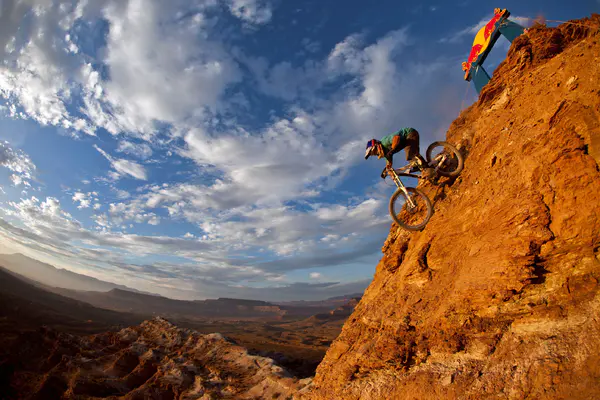Huck is a term used in mountain biking. It refers to jumping or dropping off an obstacle. When a rider hucks, they go airborne. It can be off a rock, a ledge, or a built feature. Huck is about taking risks and having fun.
Origins of the Term “Huck”
The term “huck” has roots in extreme sports. It originated from skiing and snowboarding. Riders in these sports would “huck” off cliffs and jumps. The term crossed over to mountain biking. Mountain bikers adopted the term to describe their jumps.
Why Huck?
- Thrill: Hucking is thrilling. It provides an adrenaline rush. Riders seek this excitement.
- Skill: Hucking showcases skill. It requires control and precision. Riders train to perfect their hucks.
- Progression: Hucking helps riders progress. It pushes boundaries. It allows riders to improve their abilities.
Types of Hucks
- Drops: Riders drop off a ledge or obstacle. They descend vertically. Drops require good landing technique.
- Gaps: Riders jump over a gap. It could be a natural gap or a built feature. Gaps need speed and precision.
- Step-ups: Riders jump onto a higher level. They need enough speed and power. Step-ups test a rider’s control.
Techniques for Hucking
Approach
- Speed: Maintain the right speed. Too fast or too slow can be dangerous.
- Line Choice: Pick the best line. It should be smooth and direct.
- Body Position: Stay centered on the bike. Keep your weight balanced.
Takeoff
- Pop: Use your legs to pop off the obstacle. This gives you lift.
- Timing: Time your pop correctly. Too early or too late affects the jump.
- Commitment: Commit fully to the huck. Hesitation can lead to crashes.
In the Air
- Stay Loose: Stay relaxed. Tension can cause mistakes.
- Control: Use your body to control the bike. Adjust if necessary.
- Spot Landing: Look where you want to land. This helps with accuracy.
Landing
- Absorb Impact: Use your legs and arms to absorb the impact. This reduces stress on the bike and body.
- Stay Balanced: Keep your weight centered. This helps maintain control.
- Roll Out: Continue riding smoothly. Avoid sudden stops or turns.
Safety Tips for Hucking
- Wear Protection: Always wear a helmet. Use pads for knees and elbows. Consider a full-face helmet and body armor.
- Know Your Limits: Start small. Progress gradually. Don’t attempt big hucks before you’re ready.
- Scout the Jump: Check the jump before hucking. Look for hazards. Plan your line.
- Ride with Friends: Hucking is safer with friends. They can help if something goes wrong.
- Practice: Practice on smaller jumps. Build your skills and confidence.
Common Mistakes When Hucking
- Overconfidence: Attempting hucks beyond your skill level. Leads to crashes and injuries.
- Poor Technique: Incorrect body position or timing. Affects the jump and landing.
- Lack of Commitment: Hesitating or second-guessing. Can cause loss of control.
- Ignoring Safety: Not wearing protective gear. Increases risk of injury.
- Insufficient Speed: Not enough speed for the jump. Results in coming up short.
Progressing Your Hucking Skills
Start Small
Begin with small drops. Practice technique and build confidence. Gradually increase the height.
Learn from Others
Watch experienced riders. Learn from their techniques. Ask for tips and advice.
Use Progression Features
Find trails with progression features. These offer different levels of difficulty. They help you improve step by step.
Analyze Your Hucks
Record your hucks. Watch the videos to analyze your technique. Identify areas for improvement.
Stay Fit
Maintain your fitness. Strength and endurance are crucial. They help with control and recovery.
See Also: How to Gain Confidence Mountain Biking
Famous Hucks in Mountain Biking
- Red Bull Rampage: Known for massive hucks. Riders perform jaw-dropping jumps.
- Whistler Bike Park: Features iconic hucks. A destination for huck enthusiasts.
- Fest Series: Showcases huge jumps. Riders push the limits of hucking.
Huck and the Mountain Biking Community
- Culture: Hucking is part of the mountain biking culture. It’s celebrated and respected.
- Camaraderie: Hucking fosters camaraderie. Riders encourage and support each other.
- Events: Hucking is featured in events. Competitions and festivals highlight hucking.
Hucking and Bike Setup
- Suspension: Adjust your suspension for hucking. Use more travel for bigger hucks. Set the rebound for control.
- Tires: Choose the right tires. They should provide grip and stability. Consider wider tires for more traction.
- Brakes: Ensure your brakes are reliable. Strong brakes help with control and stopping.
- Protective Gear: Invest in quality protective gear. Helmets, pads, and armor are essential.
Mental Preparation for Hucking
- Confidence: Build your confidence. Visualize successful hucks. Positive mindset helps performance.
- Focus: Stay focused on the task. Block out distractions. Concentrate on your technique.
- Calmness: Stay calm. Anxiety can affect your performance. Use breathing techniques to relax.
Conclusion
Hucking is an exciting aspect of mountain biking. It involves jumping off obstacles and taking risks. Riders huck for thrill, skill, and progression. Proper technique and safety are crucial. Start small, practice, and gradually take on bigger hucks. Hucking fosters camaraderie and is celebrated in the mountain biking community. With the right mindset and preparation, hucking can be a rewarding and exhilarating experience.

